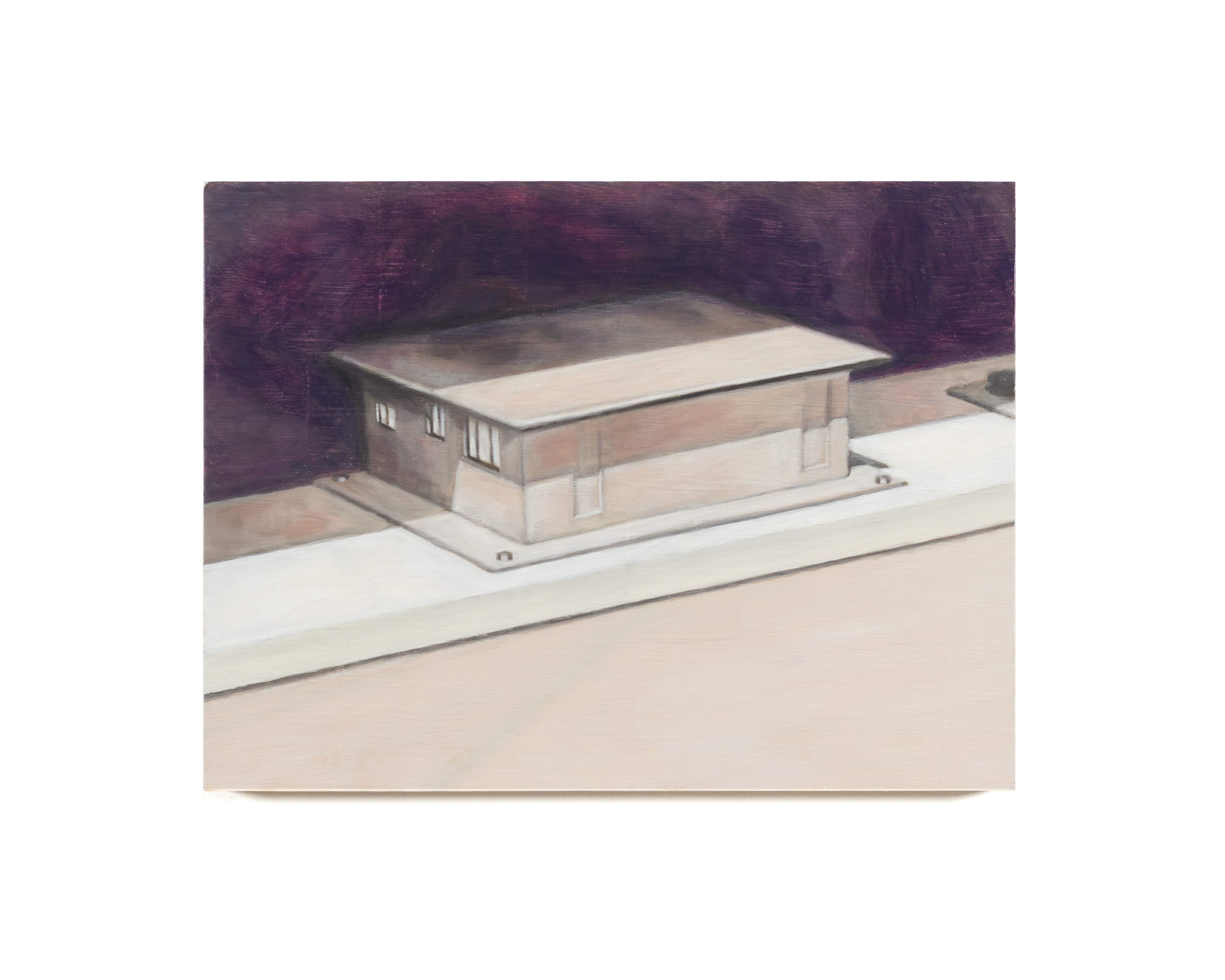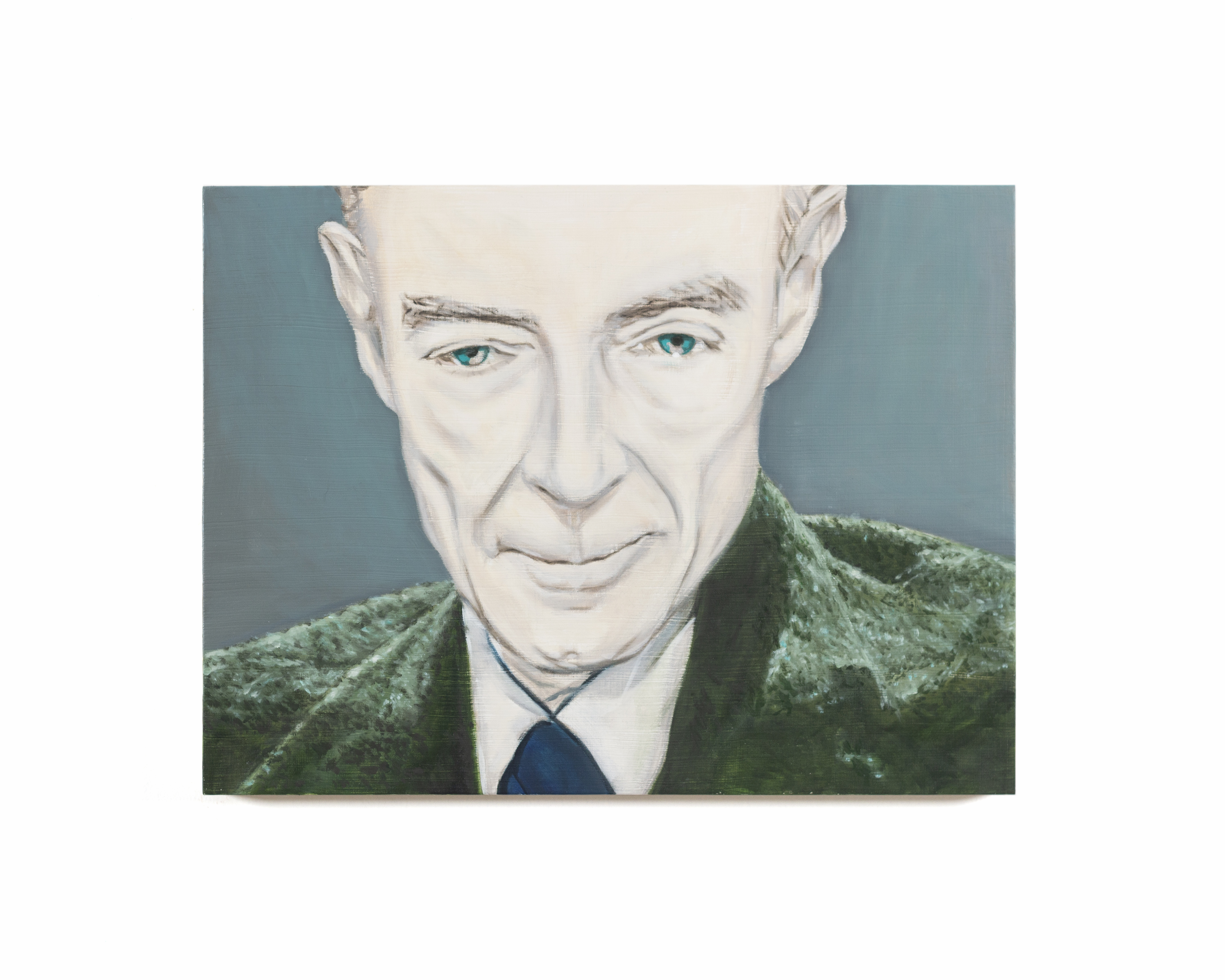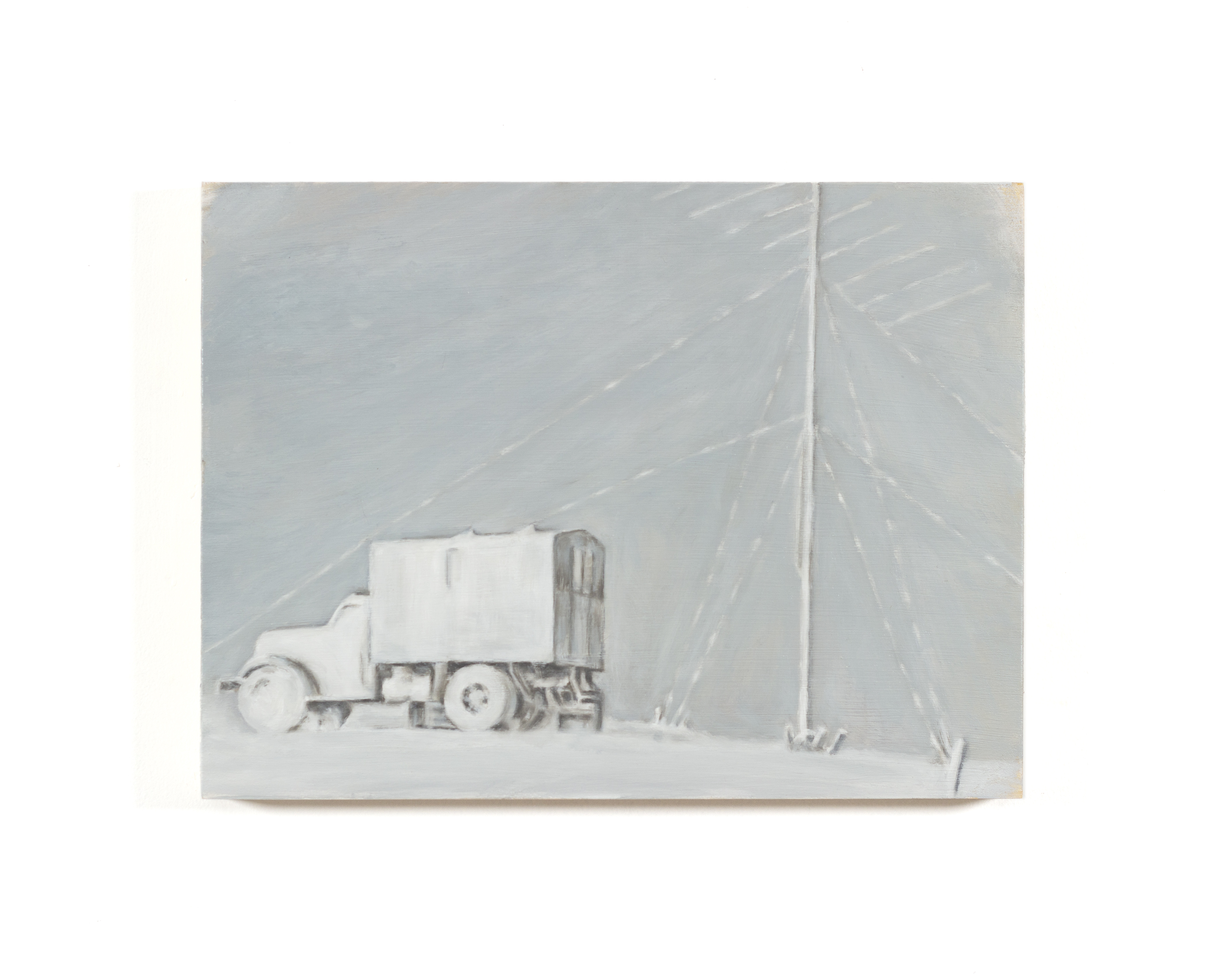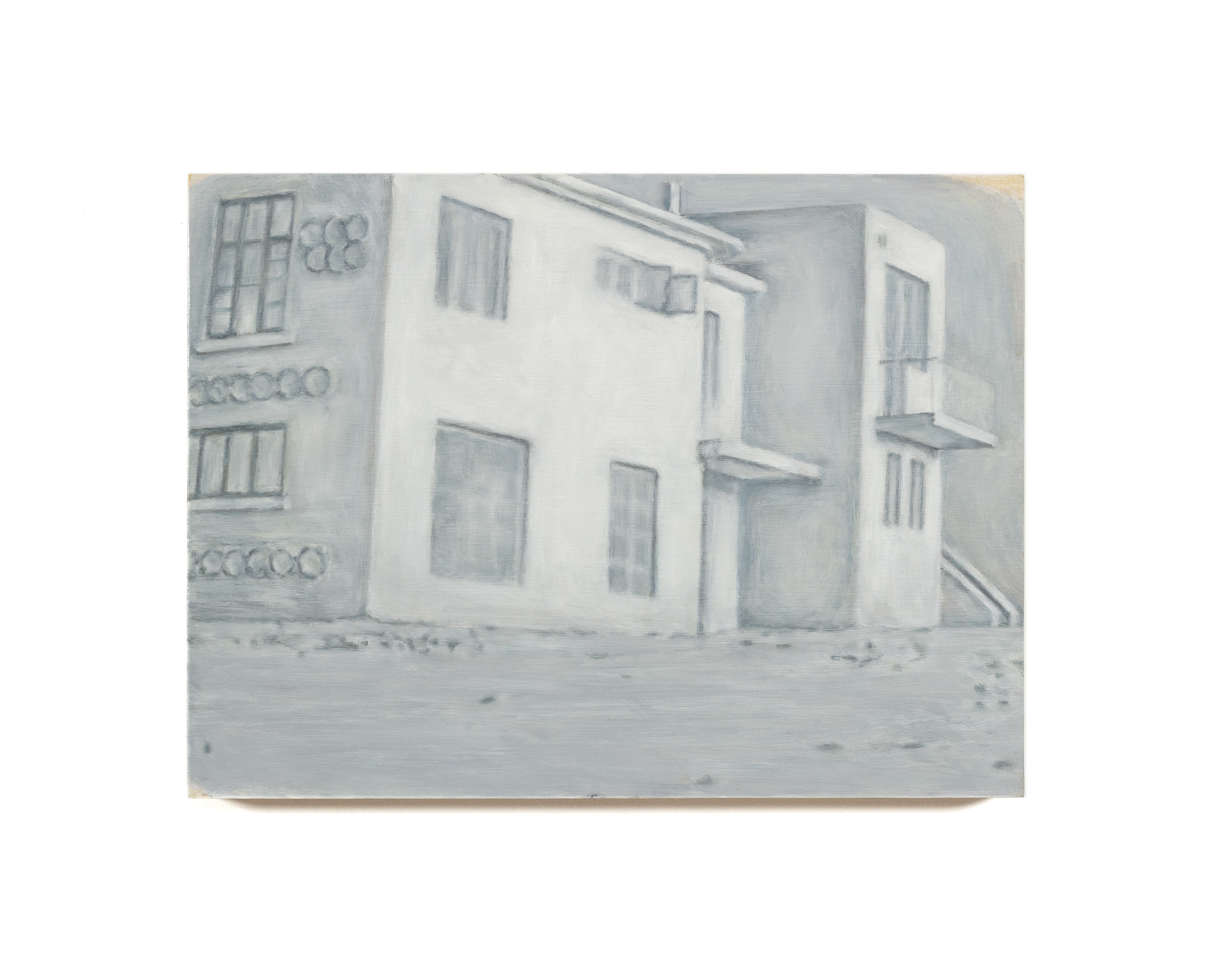这是一个关于核爆炸的逐渐发展的项目。最初的想法源于 2019 年夏天,我无意中看到了核弹实验的视频片段。被那死亡却壮丽的美所吸引,我决定剪辑一段无声的爆炸片段。多年来,我的创作素材逐渐从视频装置转向绘画,核时代的图像也出现在我的画作中。虽然我的创作跨越了不同的媒介,但对历史图像的重新审视仍然是创作过程中的一条主线。当不同来源的图像出现在我的实验和绘画中时,我意识到自己总是被冷战主题的图像所吸引。这种无意识的吸引可能是因为我出生在冷战末期,这些图像在我很小的时候就吸引了我。因此,这些我从各种渠道反复观看和挑选的图片,不仅是我重温历史的尝试,也是我了解自己的过程。无独有偶,由于乌克兰战争的持续和 "奥本海默 "电影的上映,核危机再次成为当今的热门话题。而我收藏的这些看似随意的图片,也成为了观众重新认识历史、思考当下的又一个契机。

House Model, 2023
Oil on plywood
30 x 40 cm

Nuclear Physicist, 2023
Oil on plywood
30 x 40 cm
The painting is based on clips from J. Robert Oppenheimer's television interviews in the 1960s and depicts his expression of slight bowing of the head between his words. After World War II, the nuclear physicist had been politically and psychologically affected by the consequences of the development of the nuclear bomb, and he had been campaigning for control over the development of nuclear technology. In this interview, Oppenheimer elaborates on his responsibility in development of nuclear bomb by quoting Vishnu's words to the prince in ‘Bhagavad Gita’. His speak is intermittent, his eyes are misty and glistening with tears, and he seems to purse his lips in an effort to control his emotion. The artist captures this fleeting expression and brings this black and white history back to the viewer in colour. 'Now I am become Death, the destroyer of worlds.'
这幅画是根据 1960年代奥本海默的电视采访片段创作的,描绘他言语间轻微低头的表情。在二战后,这位核物理学家政治上和心理上一直受到研制核弹后果的影响,他也一直在为核技术发展的控制而奔走。在这段采访中,奥本海默引用《薄伽梵歌》中毗湿奴对王子说的一句话阐述他在研发中的责任。他的诉说时断时续,眼神迷离,闪过泪光,似乎为了控制情绪而抿嘴。艺术家捕捉了这转瞬即逝的表情,并有彩色的画面把这段黑白的历史重新带到观众面前。“我将变成死神,世界的毁灭者。”
这幅画是根据 1960年代奥本海默的电视采访片段创作的,描绘他言语间轻微低头的表情。在二战后,这位核物理学家政治上和心理上一直受到研制核弹后果的影响,他也一直在为核技术发展的控制而奔走。在这段采访中,奥本海默引用《薄伽梵歌》中毗湿奴对王子说的一句话阐述他在研发中的责任。他的诉说时断时续,眼神迷离,闪过泪光,似乎为了控制情绪而抿嘴。艺术家捕捉了这转瞬即逝的表情,并有彩色的画面把这段黑白的历史重新带到观众面前。“我将变成死神,世界的毁灭者。”

Plasma Bubble, 2023
Oil on plywood
30 x 40 cm

A Sudden Gust of Wind, 2023
Oil on plywood
40 x 60 cm


0.1 Second before Burnt (Project 596), 2022
Oil on plywood
30 x 40 cm Each
These two paintings are derived from the 596 project archival footage, depicting the moments after the explosion of China's first atomic bomb, where everything is lit up so brightly that the human eye cannot look directly but is recorded by the camera. After 0.1 seconds, everything on the screen burned and disappeared due to the colossal energy. The paintings come from gazing at two frames of the footage that repeated pauses can only capture. This gaze is not only temporally and spatially impossible but also in terms of brightness so that the examination of the video becomes the only possibility. The seemingly monochromatic pictures are not due to the type of film but to overexposure. The artist attempts to preserve historical frames easily overlooked in the physical world through oil painting.
这是两张来自596计划视频资料画面的绘画作品,画面描绘了中国第一颗原子弹爆炸后一瞬的场景,一切都被耀眼的光芒照亮,人眼无法直视,而被摄像机记录下。0.1秒后,画面中的一切因为巨大的能量而燃烧消失。绘画作品来自于对反复暂停才能截取的一帧摄像画面的凝视。这份凝视不只时空上无法直视实物,而且亮度上也无法,于是检查视频资料成为了唯一的可能。看似单色的画面并不是由于胶片类型的原因,而是由于过度曝光。艺术家通过油画的方式,企图把容易被忽略的画面保存入物理的世界。

Before The First 1/1000 Seconnd (“Gadget”), 2023
Oil on plywood
120 x 90 cm

Lonely Landscape (Severny Island after Tsar Bomba), 2022
Oil on plywood
Triptych, 80 x 120 cm each
Untitled (Atomic Bombs), 2019
5 minutes, HD Video
From the research of the first succeed atomic bomb experiment “Trinity Project", the artist further explored the moving image source that was rare when the nuclear bomb exploded, and the difficulty of the simultaneous sound recording. Proceeding from this, he tried to use clips and reuse existing materials to capture the slow and strange sense of nuclear bomb explosions, attempting to express the hell-like horror created by nuclear weapons in another non-blasting way.
源自对第一颗成功的原子弹实验“Trinity “的影像研究,进而发掘核弹爆炸时珍惜的动态影像资料,以及素材影片同期声的困难。由此出发,试图通过剪辑再利用已有素材捕捉核弹爆炸时缓慢的诡异感,企图用另一种非爆破的方式表现核武器创造的地狱式恐怖。